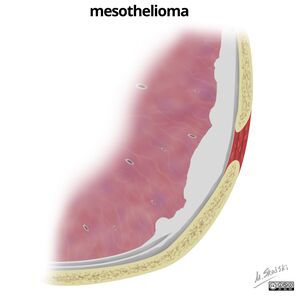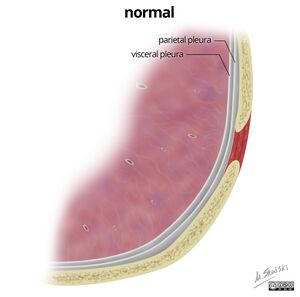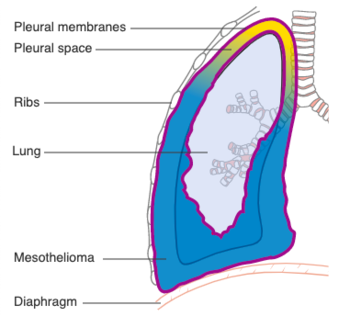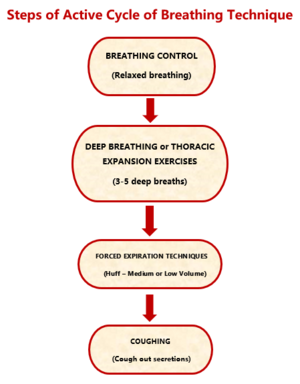Mesothelioma: Difference between revisions
No edit summary |
Kim Jackson (talk | contribs) m (Text replacement - "[[Myalgic Encephalomyelitis/Chronic Fatigue Syndrome" to "[[Myalgic Encephalomyelitis or Chronic Fatigue Syndrome") |
||
| (17 intermediate revisions by 4 users not shown) | |||
| Line 5: | Line 5: | ||
== Introduction == | == Introduction == | ||
[[File:Mesotheliomia.jpeg|right|frameless]] | |||
Mesothelioma, also known as malignant mesothelioma, is an aggressive malignant tumour of the mesothelium, with most tumours arise from the pleura<ref name=":3">radiopedia [https://radiopaedia.org/articles/mesothelioma Mesothelioma] Available from:https://radiopaedia.org/articles/mesothelioma (accessed 11.5.2021)</ref>. The subtypes of asbestos strongly associated with malignant mesothelioma are the amosite and crocidolite asbestos<ref name=":2">Jain SV, Wallen JM. Cancer, malignant mesothelioma.2018 Available from: https://www.ncbi.nlm.nih.gov/books/NBK519530/<nowiki/>(accessed 11.5.2021)</ref>. | |||
Mesothelioma | |||
Malignant pleural mesothelioma | * Affects mostly [[Older People - An Introduction|older individuals]] who have been occupationally exposed to asbestos. | ||
* Described as an insidious [[Oncology|neoplasm]] because of its long latency period—up to 40 years in some series—after exposure to asbestos. | |||
* [[File:Pleural normal.jpeg|right|frameless]]Peak incidence occurs in the 5th and 6th decades of life.<ref>Mott FE. [https://www.ncbi.nlm.nih.gov/pmc/articles/PMC3307510/ Mesothelioma: a review.] Ochsner Journal. 2012 Mar 20;12(1):70-9.</ref> | |||
* Not [[Genetic Conditions and Inheritance|genetically]] transferred <ref name=":0">Carbone M, Adusumilli PS, Alexander Jr HR, Baas P, Bardelli F, Bononi A, Bueno R, Felley‐Bosco E, Galateau‐Salle F, Jablons D, Mansfield AS. [https://acsjournals.onlinelibrary.wiley.com/doi/full/10.3322/caac.21572 Mesothelioma: scientific clues for prevention, diagnosis, and therapy.] CA: a cancer journal for clinicians. 2019 Sep;69(5):402-29.</ref> | |||
The disease is on the rise, probably due to the spread of asbestos use over past decades. The disease burden is still predominantly borne by the developed world. However, since asbestos use has recently increased in developing countries, a corresponding shift in disease occurrence is anticipated. Global mortality pattern suggests that there are early indications of this shift and lends support to the call by international organizations to eliminate asbestos-related diseases and discontinue the use of asbestos throughout the world.<ref>Delgermaa V, Takahashi K, Park EK, Le GV, Hara T, Sorahan T. [https://www.who.int/bulletin/volumes/89/10/11-086678/en/ Global mesothelioma deaths reported to the World Health Organization between 1994 and 2008. Bulletin of the World Health Organization.] 2011;89:716-24.Available:https://www.who.int/bulletin/volumes/89/10/11-086678/en/ (accessed 11.5.2021) </ref> | |||
== Etiology == | |||
[[File:Asbestos Kitchen Goods (1901) (ADVERT 299).jpeg|right|frameless|499x499px]] | |||
Malignant pleural mesothelioma is primarily linked to asbestos exposure. | |||
Image 3: During and after the Industrial Revolution, asbestos was widely used as an insulating material in the United States and Canada. Scientists have linked certain types of asbestos to three fatal diseases: lung cancer, asbestosis, and mesothelioma. | |||
* Some studies suggest that asbestos inhalation causes repeated pleural inflammation, interference with mitosis, activation of proto-oncogenes, and free radical production. | |||
* Other reports indicate associations with ionizing [[Radiation Side Effects and Syndromes|radiation]] or a germline mutation of BRCA 1 Associated Protein (BAP1). | |||
* [[Smoking Cessation and Brief Intervention|Smoking]] is not linked with malignant pleural mesothelioma, though smoking and asbestos exposure significantly increase the risk of [[Lung Cancer|lung cancer.]] | |||
Professions associated with exposure to asbestos include: | |||
* Shipbuilding | |||
* Mining | |||
* Ceramics | |||
* Cement manufacturer with asbestos | |||
* Auto parts manufacturer, especially that of brake lining | |||
* Paper mill worker | |||
* Insulation work | |||
* Railroad repair | |||
There is no evidence that alcohol, tobacco, or dietary intake is involved in malignant pleural mesothelioma<ref name=":2" />. | |||
== Epidemiology == | == Epidemiology == | ||
Mesothelioma is uncommon and accounts for 5-28% of all malignancies that involve the pleura. | |||
* There is a strong association with exposure to asbestos fibres (~10% risk during lifetime; 40-80% of patients have a history of asbestos exposure) with risk associated with duration and breadth of exposure. Paraoccupational exposure (e.g. household members of asbestos-exposed workers) can also occur. | |||
* Not all types of asbestos are strongly implicated, with crocidolite being the main causative fibre type. Given the sources of asbestos exposure being predominantly mining, construction, lagging and machinery mechanics, 60-80% of cases are encountered in males, in general, 20 to 35 years after exposure. Some areas of the world have very regional hotspots, such as Belfast in Northern Ireland, due to the historic shipbuilding industry. | |||
* There is also increased risk for those with household exposure (e.g. family of exposed workers). | |||
* There has been no convincing evidence for an association with smoking<ref name=":3" /> | |||
{{#ev:youtube|qUl18OGWGAo}}<ref>Imperial Medicine. What is mesothelioma? Available from: https://www.youtube.com/watch?v=qUl18OGWGAo [last accessed 3/8/2020]</ref> | |||
== Pathophysiology == | |||
[[File:Mesotheliomia pm.png|right|frameless|350x350px]] | |||
Mesothelial cells are much more susceptible than other cell types to asbestos cytotoxicity. When asbestos and other fibers reach the pleura and peritoneum through lymphatics, they remain in place for months or years, triggering a [[Inflammation Acute and Chronic|chronic inflammatory]] process that helps in the production of mutagenic oxygen radicals induced by asbestos are responsible for asbestos pathogenesis and carcinogenesis.<ref name=":0" /> | |||
The three types of mesothelioma are epithelioid, sarcomatoid, and mixed (epithelioid type is associated with better outcomes). | |||
* The tumor is often multifocal, forming multiple nodules starting with the parietal pleura. | |||
* Spread occurs locally in the visceral pleura before extending to the chest wall, diaphragm, or mediastinum. | |||
* Regional lymph node spread begins with the bronchopulmonary or hilar lymph nodes before moving to the carinal, internal mammary or peridiaphragmatic nodes. | |||
The pattern of nodal metastases is different from that seen in lung cancer. With malignant pleural mesothelioma, there is a direct local invasion of the lymph nodes. Overall, the involvement of lymph nodes in malignant pleural mesothelioma is not common<ref name=":2" />. | |||
== Signs and Symptoms == | == Signs and Symptoms == | ||
[[File:Dyspnea 01.png|right|frameless]] | |||
Malignant pleural mesothelioma usually presents with chest pain and [[Dyspnoea|dyspnea]]. Dyspnea suggests the presence of pleural effusion, the most common initial finding, seen in about 90% of patients. Nonspecific symptoms such as unintentional weight loss, appetite loss, cough, fatigue, and chest wall mass may also occur.<ref name=":2" /> | |||
== Diagnosis == | == Diagnosis == | ||
Diagnosis of mesothelioma is difficult to make. | Diagnosis of mesothelioma is difficult to make. | ||
Histology is a reliable prognostic marker. | * Radiological imaging (X-ray, ultrasound, Ct scan, positron-emission technology (PET)-CT or magnetic resonance imaging (MRI) ) can provide valuable diagnostic and staging information.<ref name=":1">Bibby AC, Tsim S, Kanellakis N, Ball H, Talbot DC, Blyth KG, Maskell NA, Psallidas I. [https://err.ersjournals.com/content/25/142/472 Malignant pleural mesothelioma: an update on investigation, diagnosis and treatment.] European Respiratory Review. 2016 Dec 1;25(142):472-86.</ref> | ||
* Histology is a reliable prognostic marker. | |||
== Prognosis == | == Treatment and Prognosis == | ||
Treatment continues to be challenging and the long-term survival is poor. Single modality treatment ([[Surgery and General Anaesthetic|surgery]], radiotherapy, [[Chemotherapy Side Effects and Syndromes|chemotherapy]], [[immunotherapy]] and even photodynamic therapy) have not been shown to improve survival. More recently multi-modality treatment has had some impact on favourable subgroups (early disease, and epithelioid histology). Treatment includes: | |||
* extrapleural pneumonectomy | |||
* adjuvant chemotherapy | |||
* radiotherapy | |||
The prognosis is poor for all tumour types with a median overall survival without treatment of 4-12 months. In favourable patient subgroups up to 45% 5-year survival may be achievable, however even with aggressive multi-modality therapy overall 5-year survival remains poor (3-18%) 3 with a median survival time of approximately 18 months<ref name=":3" />. | |||
== Physiotherapy management == | == Physiotherapy management == | ||
Physiotherapy is an | [[File:The Active Cycle of Breathing Technique..png|right|frameless]] | ||
Patients are encouraged to enter a rehab program to recover functionality after treatment. A good [[Nutrition|diet]] should be encouraged as most patients are [[Introduction to Frailty|frail]] and emaciated. [[Oxygen Therapy at Home|Home oxygen]] and breathing education (see '''Image''' 6 [[Active Cycle of Breathing Technique|ACBT]]) are often required<ref name=":2" />. | |||
[[Breast Cancer|Physiotherapy]] is an integral part of the multidisciplinary approach treatment for patients with cancer.<ref>Hemingway RD. [https://link.springer.com/chapter/10.1007/978-3-319-96244-3_10 Mesothelioma and Physical Therapy.] InCaring for Patients with Mesothelioma: Principles and Guidelines 2019 (pp. 99-119). Springer, Cham.</ref><br>All patients who suffer from mesothelioma are required to undergo physical therapy, even if they have already undergone surgery, chemo, and/or radiation. The reasons for this include: | |||
* All three types of treatment are exceptionally difficult on the body. With their many negative side effects, the body needs physical therapy to regain the strength it once had. | |||
* Without physical therapy, these treatment options are less successful. The body needs all the strength it can get to successfully respond to all treatment options. | |||
* Therapy with a physical therapist is usually scheduled by the medical professional. | |||
Mesothelioma treatments are designed to help patients feel more comfortable and hopefully extend their [[Quality of Life|quality of life]]. While there is no cure for mesothelioma at this time, these three treatment options are the best bet. Of course, the doctor might have other suggestions as far as using a combination of these treatments and other medications to help client live as comfortably as possible. Each case of mesothelioma is unique, meaning each treatment method will differ from others. | |||
Goals include: Respiratory care; [[Pain Mechanisms|pain management]]; improve the patient level of [[Myalgic Encephalomyelitis or Chronic Fatigue Syndrome|fatigue]]; improve bodily muscular and [[Cardiovascular Considerations in the Older Patient|cardiovascular]] endurance. | |||
== Resources == | |||
* [https://www.mesothelioma.com/ Patient resources]<br> | |||
== References == | == References == | ||
Latest revision as of 09:00, 4 January 2022
Original Editor - Raj Rindani
Top Contributors - Lucinda hampton, Kim Jackson, Manisha Shrestha, Vidya Acharya, Raj Rindani, Rucha Gadgil and Adam Vallely Farrell
Introduction[edit | edit source]
Mesothelioma, also known as malignant mesothelioma, is an aggressive malignant tumour of the mesothelium, with most tumours arise from the pleura[1]. The subtypes of asbestos strongly associated with malignant mesothelioma are the amosite and crocidolite asbestos[2].
Mesothelioma
- Affects mostly older individuals who have been occupationally exposed to asbestos.
- Described as an insidious neoplasm because of its long latency period—up to 40 years in some series—after exposure to asbestos.
- Peak incidence occurs in the 5th and 6th decades of life.[3]
- Not genetically transferred [4]
The disease is on the rise, probably due to the spread of asbestos use over past decades. The disease burden is still predominantly borne by the developed world. However, since asbestos use has recently increased in developing countries, a corresponding shift in disease occurrence is anticipated. Global mortality pattern suggests that there are early indications of this shift and lends support to the call by international organizations to eliminate asbestos-related diseases and discontinue the use of asbestos throughout the world.[5]
Etiology[edit | edit source]
Malignant pleural mesothelioma is primarily linked to asbestos exposure.
Image 3: During and after the Industrial Revolution, asbestos was widely used as an insulating material in the United States and Canada. Scientists have linked certain types of asbestos to three fatal diseases: lung cancer, asbestosis, and mesothelioma.
- Some studies suggest that asbestos inhalation causes repeated pleural inflammation, interference with mitosis, activation of proto-oncogenes, and free radical production.
- Other reports indicate associations with ionizing radiation or a germline mutation of BRCA 1 Associated Protein (BAP1).
- Smoking is not linked with malignant pleural mesothelioma, though smoking and asbestos exposure significantly increase the risk of lung cancer.
Professions associated with exposure to asbestos include:
- Shipbuilding
- Mining
- Ceramics
- Cement manufacturer with asbestos
- Auto parts manufacturer, especially that of brake lining
- Paper mill worker
- Insulation work
- Railroad repair
There is no evidence that alcohol, tobacco, or dietary intake is involved in malignant pleural mesothelioma[2].
Epidemiology[edit | edit source]
Mesothelioma is uncommon and accounts for 5-28% of all malignancies that involve the pleura.
- There is a strong association with exposure to asbestos fibres (~10% risk during lifetime; 40-80% of patients have a history of asbestos exposure) with risk associated with duration and breadth of exposure. Paraoccupational exposure (e.g. household members of asbestos-exposed workers) can also occur.
- Not all types of asbestos are strongly implicated, with crocidolite being the main causative fibre type. Given the sources of asbestos exposure being predominantly mining, construction, lagging and machinery mechanics, 60-80% of cases are encountered in males, in general, 20 to 35 years after exposure. Some areas of the world have very regional hotspots, such as Belfast in Northern Ireland, due to the historic shipbuilding industry.
- There is also increased risk for those with household exposure (e.g. family of exposed workers).
- There has been no convincing evidence for an association with smoking[1]
Pathophysiology[edit | edit source]
Mesothelial cells are much more susceptible than other cell types to asbestos cytotoxicity. When asbestos and other fibers reach the pleura and peritoneum through lymphatics, they remain in place for months or years, triggering a chronic inflammatory process that helps in the production of mutagenic oxygen radicals induced by asbestos are responsible for asbestos pathogenesis and carcinogenesis.[4]
The three types of mesothelioma are epithelioid, sarcomatoid, and mixed (epithelioid type is associated with better outcomes).
- The tumor is often multifocal, forming multiple nodules starting with the parietal pleura.
- Spread occurs locally in the visceral pleura before extending to the chest wall, diaphragm, or mediastinum.
- Regional lymph node spread begins with the bronchopulmonary or hilar lymph nodes before moving to the carinal, internal mammary or peridiaphragmatic nodes.
The pattern of nodal metastases is different from that seen in lung cancer. With malignant pleural mesothelioma, there is a direct local invasion of the lymph nodes. Overall, the involvement of lymph nodes in malignant pleural mesothelioma is not common[2].
Signs and Symptoms[edit | edit source]
Malignant pleural mesothelioma usually presents with chest pain and dyspnea. Dyspnea suggests the presence of pleural effusion, the most common initial finding, seen in about 90% of patients. Nonspecific symptoms such as unintentional weight loss, appetite loss, cough, fatigue, and chest wall mass may also occur.[2]
Diagnosis[edit | edit source]
Diagnosis of mesothelioma is difficult to make.
- Radiological imaging (X-ray, ultrasound, Ct scan, positron-emission technology (PET)-CT or magnetic resonance imaging (MRI) ) can provide valuable diagnostic and staging information.[7]
- Histology is a reliable prognostic marker.
Treatment and Prognosis[edit | edit source]
Treatment continues to be challenging and the long-term survival is poor. Single modality treatment (surgery, radiotherapy, chemotherapy, immunotherapy and even photodynamic therapy) have not been shown to improve survival. More recently multi-modality treatment has had some impact on favourable subgroups (early disease, and epithelioid histology). Treatment includes:
- extrapleural pneumonectomy
- adjuvant chemotherapy
- radiotherapy
The prognosis is poor for all tumour types with a median overall survival without treatment of 4-12 months. In favourable patient subgroups up to 45% 5-year survival may be achievable, however even with aggressive multi-modality therapy overall 5-year survival remains poor (3-18%) 3 with a median survival time of approximately 18 months[1].
Physiotherapy management[edit | edit source]
Patients are encouraged to enter a rehab program to recover functionality after treatment. A good diet should be encouraged as most patients are frail and emaciated. Home oxygen and breathing education (see Image 6 ACBT) are often required[2].
Physiotherapy is an integral part of the multidisciplinary approach treatment for patients with cancer.[8]
All patients who suffer from mesothelioma are required to undergo physical therapy, even if they have already undergone surgery, chemo, and/or radiation. The reasons for this include:
- All three types of treatment are exceptionally difficult on the body. With their many negative side effects, the body needs physical therapy to regain the strength it once had.
- Without physical therapy, these treatment options are less successful. The body needs all the strength it can get to successfully respond to all treatment options.
- Therapy with a physical therapist is usually scheduled by the medical professional.
Mesothelioma treatments are designed to help patients feel more comfortable and hopefully extend their quality of life. While there is no cure for mesothelioma at this time, these three treatment options are the best bet. Of course, the doctor might have other suggestions as far as using a combination of these treatments and other medications to help client live as comfortably as possible. Each case of mesothelioma is unique, meaning each treatment method will differ from others.
Goals include: Respiratory care; pain management; improve the patient level of fatigue; improve bodily muscular and cardiovascular endurance.
Resources[edit | edit source]
References[edit | edit source]
- ↑ 1.0 1.1 1.2 radiopedia Mesothelioma Available from:https://radiopaedia.org/articles/mesothelioma (accessed 11.5.2021)
- ↑ 2.0 2.1 2.2 2.3 2.4 Jain SV, Wallen JM. Cancer, malignant mesothelioma.2018 Available from: https://www.ncbi.nlm.nih.gov/books/NBK519530/(accessed 11.5.2021)
- ↑ Mott FE. Mesothelioma: a review. Ochsner Journal. 2012 Mar 20;12(1):70-9.
- ↑ 4.0 4.1 Carbone M, Adusumilli PS, Alexander Jr HR, Baas P, Bardelli F, Bononi A, Bueno R, Felley‐Bosco E, Galateau‐Salle F, Jablons D, Mansfield AS. Mesothelioma: scientific clues for prevention, diagnosis, and therapy. CA: a cancer journal for clinicians. 2019 Sep;69(5):402-29.
- ↑ Delgermaa V, Takahashi K, Park EK, Le GV, Hara T, Sorahan T. Global mesothelioma deaths reported to the World Health Organization between 1994 and 2008. Bulletin of the World Health Organization. 2011;89:716-24.Available:https://www.who.int/bulletin/volumes/89/10/11-086678/en/ (accessed 11.5.2021)
- ↑ Imperial Medicine. What is mesothelioma? Available from: https://www.youtube.com/watch?v=qUl18OGWGAo [last accessed 3/8/2020]
- ↑ Bibby AC, Tsim S, Kanellakis N, Ball H, Talbot DC, Blyth KG, Maskell NA, Psallidas I. Malignant pleural mesothelioma: an update on investigation, diagnosis and treatment. European Respiratory Review. 2016 Dec 1;25(142):472-86.
- ↑ Hemingway RD. Mesothelioma and Physical Therapy. InCaring for Patients with Mesothelioma: Principles and Guidelines 2019 (pp. 99-119). Springer, Cham.












